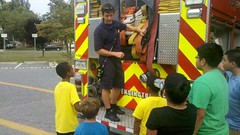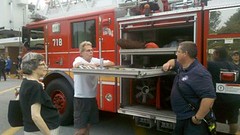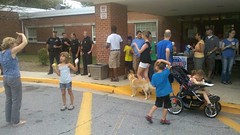by Rocky Lopes
Emergency Manager with a social science background
We all probably have some story to tell about where we were and what we were doing when "it" happened: a 5.8M earthquake that rattled states from Georgia to New England at 1:51pm ET on August 23, 2011. The
earthquake's origin was shallow, which is why the shaking could be felt over such vast distances. The earthquake originated near Mineral, Virginia, about 90 miles south of Washington, D.C.
Some people think that earthquakes only happen along plate boundaries, such as the very well-known San Andreas Fault in California where the Pacific Plate, Juan de Fuca Plate, and the North American Plate meet.
These crustal plates grind against each other, build up stress and strain, and occasionally release the stored energy as an earthquake.
What we experienced in the DC area on August 23 was the reality that earthquakes can happen in areas other than where crustal plates meet. These quakes are harder to predict than earthquakes that happen at plate boundaries, and they happen with much less frequency. According to the U.S. Geological Survey, the last time an earthquake of that magnitude happened in the Virginia Seismic Zone was in May, 1897 -- 114 years ago.
Most people in our area are not familiar with what an earthquake feels like. As described in various media reports, a lot of people called out, "what's that?" and immediately began to think something happened
like a truck striking their building, a Metrorail car crashing, or a bomb going off. Unfortunately in these times just about ten years after the September 11, 2001, terrorist attacks, we have been conditioned to anticipate those types of things. Here on the East Coast, we are not conditioned to expect an earthquake, because the general perception is, "they don't happen here." Well, I've gone news for you: they do!
The process of trying to figure out what an unusual occurrence is by comparing it with past experience is called in the social science field, "normalization." So it was appropriate, although wrong, that people
responded by evacuating buildings instead of doing the earthquake safety action: drop, cover, and hold on. Since September 11, 2001, we have been drilled in evacuation procedures, so people did what they were
familiar with. On the East Coast, though, we have not practiced what to do in an earthquake with "drop drills" like they do on the U.S. West Coast and Alaska.
Further, some people mistakenly believe that many buildings collapse in an earthquake. Frightening images from the few buildings that actually have had structural failure are remembered and people think, "buildings
here aren't built to withstand an earthquake, so we have to run outside, right now!" The thing is, IF a building were going to have structural failure due to an earthquake, the failure would happen while the shaking is happening. There is a lot of data that shows that people who move more than a few feet from where they are during violent earthquake shaking are highly likely to be injured -- so that's why staying put by dropping to the floor, covering your head and neck with your hands, and holding on to the table you are under is the best action to take, because that action will protect you from things that could fall on you (lights, ceiling tiles, bookcases, mirrors, framed pictures, etc.)
Considering the recommended "drop-cover-hold on" procedure, we run into another social science issue called "counterintuitive action." That is, our sense of personal safety invokes our "fight or flight" response when confronted with a scary feeling -- in this case, the floor below our feet rocking and rolling. The intuitive action is to flee while the correct action is to stay and take cover to prevent things from falling on you.
For more information about why "drop-cover-hold on" is the correct earthquake safety action, please see this website:
Drop, Cover, Hold which is written by good friends of mine.
Then we also have to be concerned that running into urban streets during an earthquake or after may expose us to being hit by shattering glass from buildings. This has happened all over the world in earthquakes and
aftershocks.
The challenge confronting us is to learn these things from this experience:
1. We can have earthquakes and feel earthquake shaking here on the East Coast.
2. The safest thing to do is to "drop, cover, and hold on" right where you are -- even if the response counters what your "fight or flight" response is telling you.
3. To avoid gridlock on roadways, it's best to stage leaving and returning home over a period of time. When everyone tries to leave at the same time, that the capacity of public transit and roadways is overwhelmed.
4. Understand that emergency officials take precautions to ensure the safety of building occupants, so they may set off a fire alarm or call for an evacuation because they are concerned that a fire could start, a gas line could have broken, or structural damage could happen. Grab your personal belongings (car keys, cell phone, purse, brief case). Follow the instructions, and leave. You may not be allowed to return to your building until it has been inspected by building engineers.
5. Concern for loved-ones is common, but the capacity of the cell phone network is quickly overwhelmed when everyone tries to use it at the same time. Remember, it is against the law to use a hand-held device to place a call or send a text while operating a motor vehicle. If you weren't able to reach your loved-ones before getting in your car to drive home, you should not try to contact them via a hand-held mobile device while on the road. Your life and the lives of others is at stake! If you must, pull over and use the device from a safe location.
All-in-all, we can take the August 23 as a very good learning experience. Take some time to practice "drop, cover, hold-on" with your loved-ones. Make it a game with the kids. Do it at work. The next time the floor under your feet rolls, you'll recognize an earthquake when you feel it and be confident that you know how to protect yourself from injury, and by practicing with your loved-ones, that they will be safe, too.



















